All Garlic Oil is Not Created Equal
In our extended communication with Monash University during the development of our own recipe for Low FODMAP Garlic-Infused Oil, we learned how they make decisions about what garlic oils are considered appropriate for the low FODMAP diet and which are not.
We have used that information to inform this article as well as the information in our sister article, FODMAP Everyday’s Recommendations for Commercial Garlic-Infused Oils.
Ultimately, if a product is not certified as low FODMAP by either FODMAP Friendly or Monash University, we invite you to use the knowledge presented here to make your own best decision as an informed consumer.
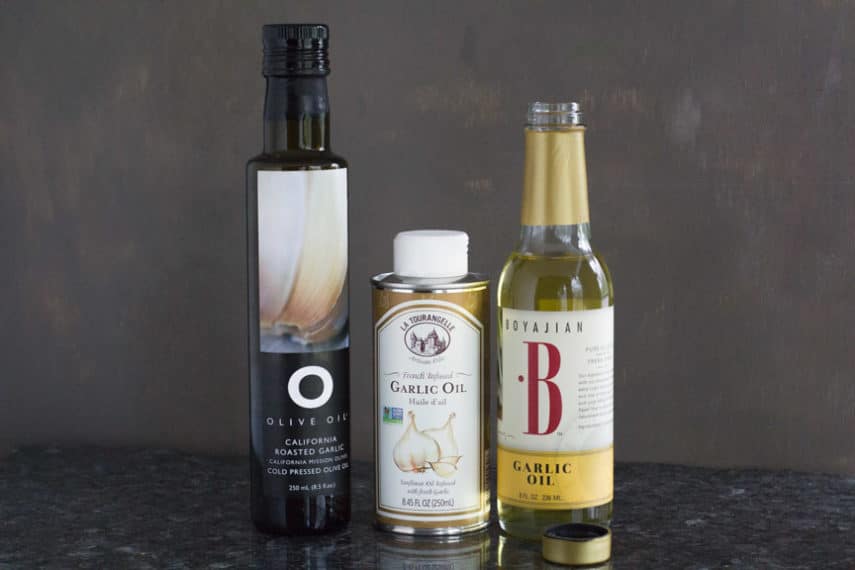
Can You Have Garlic, Or Not?
For a great majority of people new to the low FODMAP diet, the most devastating news that they hear from their RDN is that garlic, which contains the FODMAP fructans, is off-limits during the Elimination Phase of the diet. Eventually, during a structured Challenge phase, one might discover that garlic has to be banished from their diet long term, due to it being a main IBS trigger for many.
I was that person, too. Food without garlic? What about my favorite Mexican food? What about my weekly roast chicken? What about my Mom’s marinara sauce – heck, what about jarred tomato sauce when I’m in a pinch? It was a dizzying and depressing thought.
BUT, don’t fret. You CAN still enjoy garlic flavor.
As Kate Scarlata RDN and I began to work on our book, we discussed there fact that the offending fructans in garlic are water-soluble, but not oil soluble. This means that you can consume Garlic-Infused Oil.
But what is garlic-infused oil and is all oil labeled as “garlic-infused” okay for us to consume?
(After reading this article you should also check out our Recommendations for Commercial Garlic Infused Oils).
What Does “Garlic-Infused” Mean?
There is a lot of confusion is with the word “infused”. In the English language we might say something is “infused” with a particular flavor to denote that the flavor is present in that food. But how the flavor got there could be through any manner of ways.
For instance, you could chop up garlic and put it in a recipe, like a pot roast or spaghetti sauce, and say that the dish is “infused with garlic flavor” and from a grammatical standpoint, you would be right – yet this would be high FODMAP because the garlic solids remain present – and even if the garlic solids were removed at any point – the water-soluble fructans inherent in the garlic would have become inextricably intertwined with the ingredients in your pot, having combined with any of the ingredients that contain water, such as meat, tomatoes, vegetables, broth, wine, etc.
We have to get technical, specific and scientific.
- The Merriam-Webster medical definition of “infusion” relates to something, often a solid, steeped in liquid (often water) without boiling so as to extract the soluble constituents or principles.
- In cooking, there is a preparation technique called “infusion” where a flavoring agent soaks in a liquid for a period of time and then the solid is removed.
You can see how the two definitions are similar, and both, if referencing garlic as the solid, and oil as the liquid, with the solids removed, would result in a low FODMAP “garlic-infused” oil.
However, as stated before, in the English language, we use the terms “infused” and “infusion” in much broader terms and unfortunately, this could be misleading if we are specifically reading labels to detect FODMAPs.
Infused? Confused?
To complicate matters further, some commercial labels of oil products state “garlic-infused” when the actual manufacturing process is not a true garlic infusion technique and the resulting product is not (or potentially not) low FODMAP.
And other brands that do use a true infusion process do not label their product as such and might just say “garlic oil”.
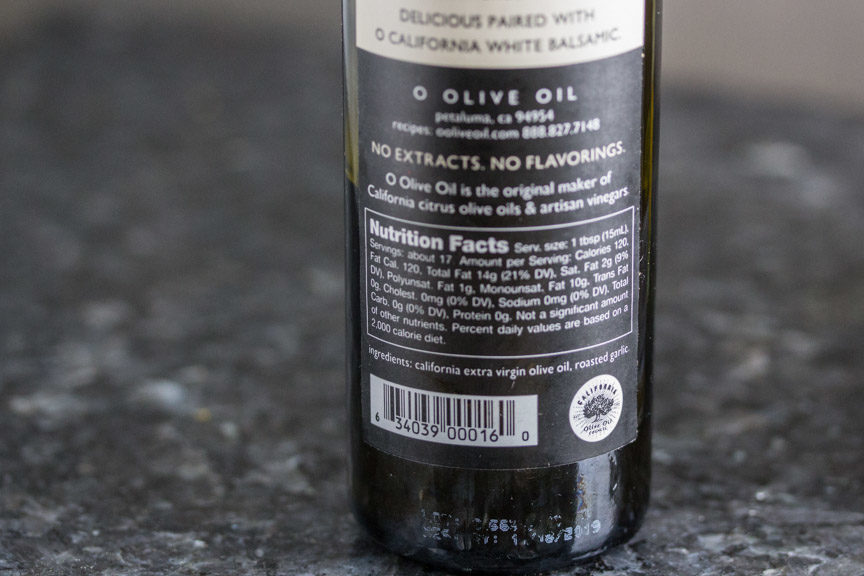
Possibly the most frustrating thing we learned during our investigation is that many of the products that we initially researched online do not provide any ingredient information whatsoever.
And even if you call for further clarification, many times the oil is made by a separate company from the one on the label and the person on the phone is seriously lacking in information. Confusing? Very.
So We Became Garlic Oil Detectives!
So, how do you know if you cannot discern from the front of the label, or the ingredient list on the back, which oil is safe? That’s what this article is about.
Let’s define what we are looking for and what we are looking to steer clear of.

Garlic Infused Oils Defined
Low FODMAP Garlic-Infused Oils: What We Want
These oils, whether they are made with some sort of vegetable oil, olive oil or a blend of oils are made by letting the garlic cloves marinate for a period of time in the oil, which is also usually heated. It is important that no other food ingredient is present. Once the garlic has lent its flavor to the oil (and brands do vary in strength), all the garlic solids must be removed. This results in a true garlic-infused oil, which is low FODMAP.
Commercially prepared products sometimes include a preservative, such as citric acid and that is okay from a FODMAP perspective.
We think that these oils, using a true infusion process with fresh garlic, have the best flavor. They are also in the minority. (Which is why we suggest making your own). You will see as you begin to read garlic oil labels that many, if not most, are flavored with a garlic flavored products and not garlic itself. More on that below.
There are also some low FODMAP oils made with roasted garlic and in some cases the preparation technique is low FODMAP – but not always.
High FODMAP Garlic Oils: What To Look Out For
An obvious “tell” is any oil that has garlic pieces or solids, whether fresh, dried or roasted, floating in the bottle. Leave those on the shelf.
Any oil that is flavored with garlic through the use of “garlic oil”, “garlic essential oil”, “garlic essence”, “garlic flavoring”, “natural roasted garlic flavor”, natural flavor” or anything similar has the potential of triggering symptoms. This is not a FODMAP content comment; it is an “IBS trigger” comment.
You can use the FDA label to help you. If the Carbohydrate amount is 0%, then there are no FODMAPs in the serving size recommended, as FODMAPs are carbohydrates.
Please read our article on reading and understanding an FDA Nutrition Facts Label for more info.
In our clinical experience, this does NOT guarantee that you might not react to the product. We hear from folks all the time that they have used a garlic oil product, that it has 0% carbohydrates, and yet they still experience digestive upset. Again, this is not a FODMAP issue, but it is reported frequently enough that we think it is important to address.
Everyone has a unique digestive tract and the key is getting to know what works for you. Consider this article a guideline to helping you figure out your best choices.
We have heard repeatedly from many following the diet that they can experience IBS triggers with commercially prepared garlic “infused” products, but they do just fine with homemade. Don’t give up! Try our recipe.
BTW we have an Onion-Infused Oil recipe, too. Onions also contain water-soluble fructans and our oil is a great item to have around.
What Is Natural Flavor?
According to the FDA “natural flavor or natural flavoring means the essential oil, oleoresin, essence or extractive, protein hydrolysate, distillate, or any product of roasting, heating or enzymolysis, which contains the flavoring constituents derived from a spice, fruit or fruit juice, vegetable or vegetable juice, edible yeast, herb, bark, bud, root, leaf or similar plant material, meat, seafood, poultry, eggs, dairy products, or fermentation products thereof, whose significant function in food is flavoring rather than nutritional,” which means that if a product contains “natural flavors”, we cannot support it as low FODMAP before doing additional research.
Why? Because you could have a garlic oil product that contains a “natural flavor” and we wouldn’t actually know what the original foodstuff was that provided the “garlic flavor”.
Believe it or not, it doesn’t necessarily mean it was garlic used for the “flavoring” and it could very well be another high FODMAP food source. And even if you call the manufacturer, they often do not know either.
You would have to know what company they get their flavoring from and most companies do not want to divulge such information.
You can read an entire article on natural flavors here.
No, Seriously, What Is It?
In fact, 100% of the companies that I spoke to for our oil articles who use a flavoring had no idea what was actually in the flavoring or how it was produced. They just know they want a garlic flavor, they find a company who offers such a product and that’s what they use.
Many of them were suspicious of my inquiries, thinking I was a competitor trying to figure out how make the product and stated flatly that they would not give me all the information I sought – even after I explained that it was a health issue.
Others were just very confused and couldn’t understand why I needed this information.
And, by the way, while a “natural flavor” will have derived originally from a natural source, it is so highly processed that most dietitians will tell you that there is little difference from artificial flavors. In other words, “natural flavors” are not necessarily “healthier” than artificial flavors.
And Then There Are Essential Oils
Essential oils are all the rage with aromatherapy fans and they sound pure and good. Oil from garlic, which might be called “garlic oil”, “essential garlic oil” or “garlic essential oil” can be found on many garlic flavored oil labels.
We have had FODMAPers tell us that they experience digestive upset when ingesting products containing these ingredients.
Garlic essential oil might be good for acne or ear infections (not that we are recommending this but these are uses you will find mentioned elsewhere) but without being a certified low FODMAP product, we take the conservative approach and do not recommend these oils across the board, per Monash researcher’s recommendations.
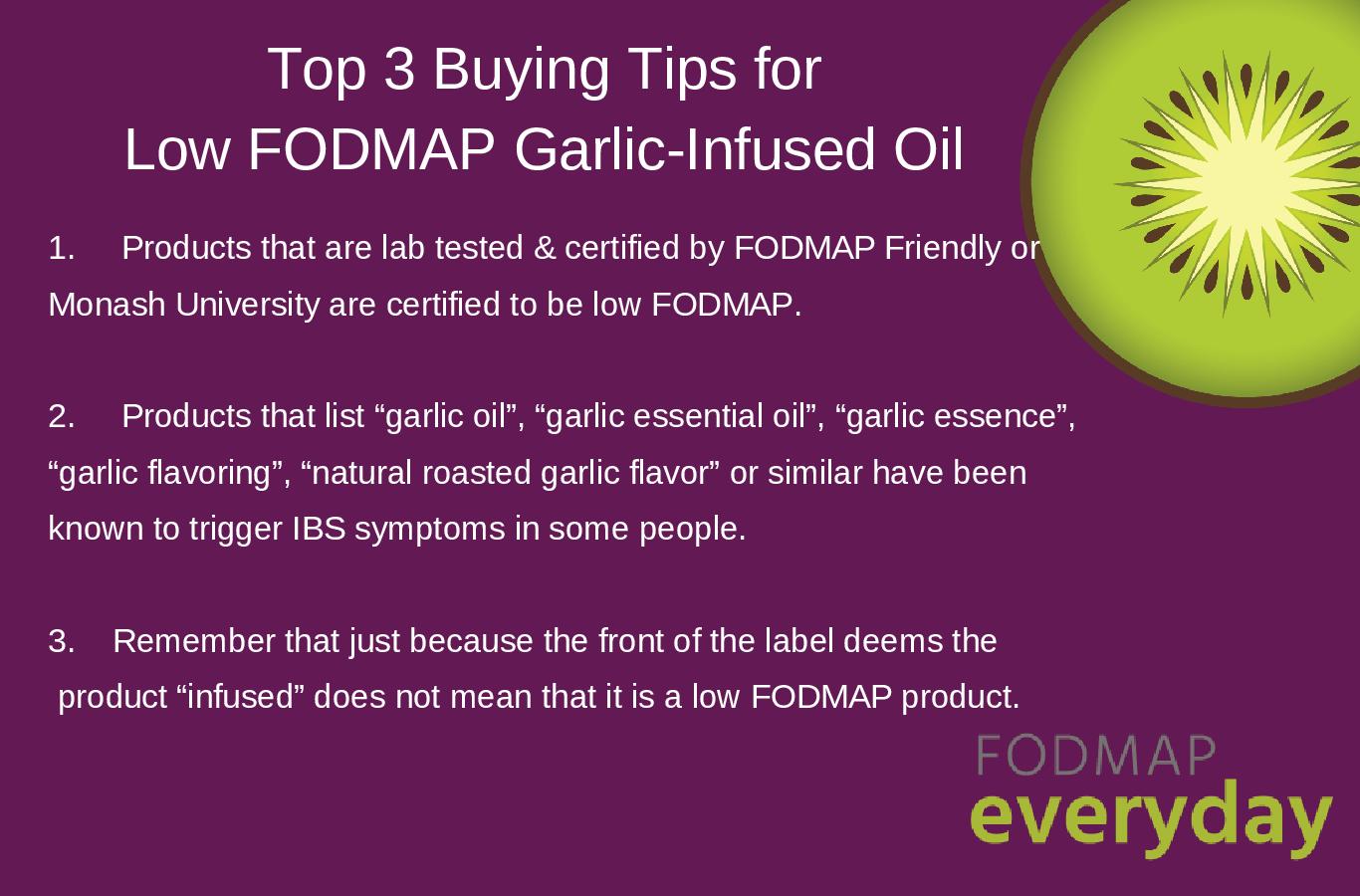
Four Important Caveats
Firstly, as we discuss in our article on natural flavoring, if an ingredient is less than 2% (sometimes indicated on a label, sometimes not) it is unlikely to trigger symptoms. This does not mean that it is impossible to trigger symptoms. YOUR reactions to a food is what is important.
Secondly, as stated above, if the FDA panel says there are 0% carbohydrates, the product is low FODMAP by definition.
Thirdly, we know that some folks still experience reactions when using products that have 0% carbohydrates. These reactions are not FODMAP based, but the reactions are consistent enough that we believe it is worth discussing.
And Fourthly, in specific conversations about garlic flavored oil with Monash University, they have repeatedly stated that if a product has not been lab tested and certified low FODMAP, then it cannot be guaranteed to be low FODMAP.
Do some of these facts appear to contradict one another? Yes. What’s the saying? Don’t kill the messenger? That’s us, the messenger. We are just bringing you all the information that we have at our disposal.
Remember, the right low FODMAP serving size for you is the amount of a food or product that does not trigger symptoms for YOU. We have an article on What Is A Low FODMAP Serving Size? that you might find helpful.
Our Takeaway
Be prudent. There are garlic-infused oils that we believe are safe for FODMAPers to use, based on the available information from current FODMAP research and the oil manufacturers themselves.
Oils made in the true infusion manner, such as our homemade recipes, are safe.
Oils (and any products) that have been through a low FODMAP certification process, via lab testing, are safe. Currently, FODMAP Friendly and Monash University both have certification programs and products will have their certification logos on the label.
Look for one of these logos below.
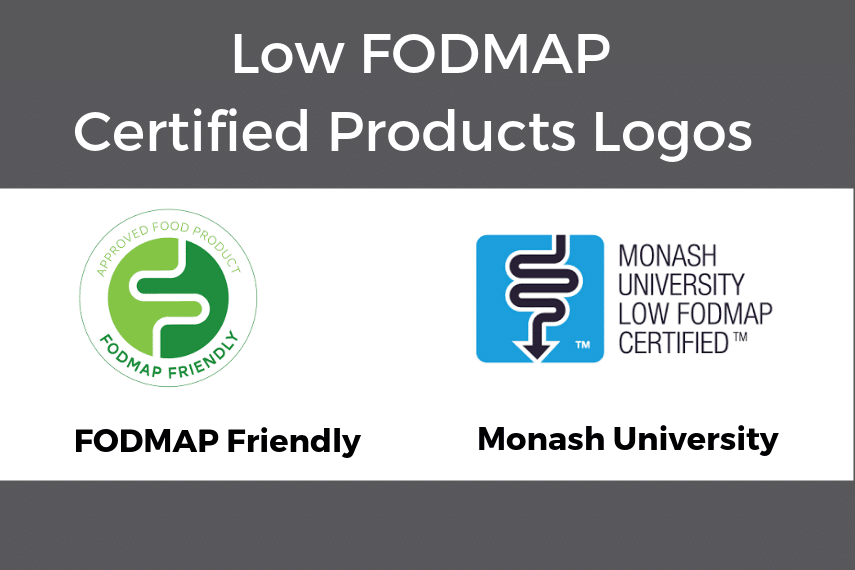
Many garlic-flavored oil products have 0% carbohydrates, which means, by definition, they are low FODMAP.
Researchers at Monash University directed us that their stance is that if a garlic oil product has not been lab tested, then there is no guarantee that it is low FODMAP.
If you have a bottle of garlic oil that your digestive system has been happy with, regardless of what is on the label, then by all means, keep using it.
And conversely, if you are reacting to a product, whether it is certified or not, then cease using it.
As always, we recommend that you make dietary decisions in conjunction with your medical team.
Go here for our list of Recommended Brands of Garlic Infused Oils.


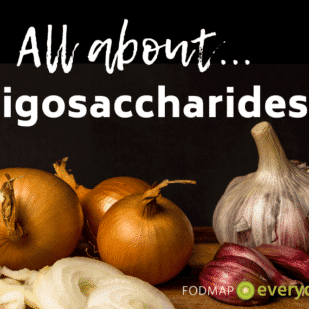






Thank you for this information! What about Zeta extra virgin with basil and garlic? Ingredients are extra virgin olive oil, garlic and basil extract? Thank you so much for your wonderful website!
Hi Sarah, we are so glad you are enjoying the site. It was difficult to find information about this brand but it is kosher and hails from Israel. Firstly, the product is not low FODMAP certified so everything I am about to say is an educated guess. Going by your ingredient description, here are my thoughts: It looks like both the garlic and basil are extracts. While I would say go ahead and try the oil to see if it sits well with you digestively – because that is what is important – one of my main questions would be taste. Chances are that neither the garlic flavor or the basil flavor will be very fresh and true. This is a personal opinion, of course. Have you been using it? How has it been for you? If you haven’t tried our recipe, give it a go!
Sorry – but my question has not been answewed: I wish to know –
Can I Swallow pre-Fermented, Aged Black f Pure, Dry Garlic Capsules (‘KYOLIC’) when I’m following the ‘ Low FOODmap Diet ‘??
Thanks for your Advice.
This supplement has not been tested formally for FODMAPs but we spoke to the manufacturer and there is actual garlic mass in the capsules. Not only that, but there is dairy whey and untested seaweed (all high FODMAP). This would be considered a high FODMAP product. Always follow the advice of your dietitian. Personally, I would not take this product.
This is the best garlic extract product from amazon
https://www.amazon.com/dp/B06XC5ZFQ2
Hi John, we tried to reach out to the manufacturer but their site is unavailable and they are not answering their phone. We aren’t sure why you are pointing this product out. As you can see on the label, this product is alcohol based, as most extracts are. If it has been prepared by soaking garlic with alcohol to infuse the alcohol (which we are betting on) then this is a high FODMAP product. We certainly would not recommend it while on the low FODMAP diet. It may very well be a great garlic extract product, but that doesn’t make it low FODMAP or suitable for use while following the diet.
Hello. Thanks for this thorough description and not dumbing it down. I have a point I don’t think this discussion has considered. I understand your explanation of how we can’t be sure garlic extracts or flavouring from a steam distillation or pressing would be low FODMAP. But I would suggest in the case of oil products there is any easy way to tell if it’s safe; Read the nutritional info. FODMAPs are carbohydrates. If a product says zero carbohydrates, it’s zero FODMAP. What am I missing?
Thank you for writing! Here is an issue to consider: there are argumato style garlic oils, which means the garlic is crushed right along with the olives during manufacturing and production. These labels will say zero carbohydrates, and yet, the fructans are in the mixture. This is why, unless a product is lab certified, we cannot know for sure. Of course we can always use good judgement – and/or try items for ourselves to see how our digestion handles it.
I bought some truly fantastic california olive oils cold pressed with garlic. Some very lovely, intense flavors. I felt I struck gold. And then the symptoms. Was pretty bummed … still looking for a recipe that will get me a truly potent garlic infused EVOO.
Thank you for your article,
The fact is that even when a commercially prepared garlic “flavored” olive oil is low FODMAP, we hear anecdotally that folks often experience digestive upset. Have you tried making your own? That might be the next step!
Very comprehensive! Thank you! I’m still not sure about a potential product I’m looking into that says they are’natural garlic extract spice drops’ It lists ‘garlic extract (oleoresin) and sunflower oil’as it’s two ingredients? Thanks for your help.
Claire
Our suggestion is to try it. Some folks have strong triggers to oils with those ingredients – and many don’t! The only thing we know is that they are not lab tested. But how YOU do with them is what is ultimately important.
You do not mention garlic pressed olive oils (aka fused oils or agrumato oils) where whole garlic is crushed along with the olive s and the oil pressed from the combination of both. This is the traditional method for producing flavoured olive oils before commercial producers were able to source flavourings to add to their olive oil.
Hi Monica, we do discuss this in the companion article and also extensively in the comments on that page. As previously stated, the agrumato process where olives and garlic are crushed together will result in great tasting oil that WILL contain fructans. The garlic can only come into contact with pure oil to remain low FODMAP. In the agrumato process it comes in contact with the olives, which contain water, and the fructans will leach out into the resulting liquid.
I have been using cobram extra virgin galic infused oil and because i am still having symptoms of ibs while eliminatng known triggers, i am wondering if this oil is low fodmap. I am in australia.. not sure od the brand s other have commented on. Could you please advise.
Hi Shirley, Cobram Garlic-Infused Extra Virgin Olive Oil has been lab tested to be low FODMAP by FODMAP Friendly. This means that it is a low FODMAP product. But as I am fond of saying, you are not a lab. If a food is bothering you, then by all means remove it from your diet. Note, however, that it is not a FODMAP reaction to this oil. You might find this article helpful on Timing of Symptoms.
I just wanted a yes or no on Kyolic aged garlic , is it going to affect Gluten intolerance and also IBS.
I just get confused when trying check up on line.
Hi June, I will address this in a few ways for clarity. No one knows how the product will affect your gluten intolerance or your IBS. Only you can assess that after a structured Elimination Phase and during a structured Challenge Phase. Your reactions can be unique, so looking to others won’t help. In terms of whether the products contain FODMAPs (which I know you didn’t ask, but I am going to answer anyway), the products have not been lab tested for FODMAPs, so no one knows. We see this a lot, where someone looks up something online and cannot find info and get confused. A simple way to think about it is to Always check BOTH the Monash and the FODMAP Friendly apps as they are the only two entities testing products. If a product isn’t listed, it hasn’t been tested. If you know that you have fructan sensitivities, then most likely this will not be a good line of products for you BUT again, your individual reaction is what will tell you.
I just found your site and love it!
I have always understood 0% on an FDA label to have a different meaning. I thought it meant less than .05%, or perhaps a lower amount.
Hi Liz I am not sure what your comment is addressing. Perhaps you can clarify?
Hiya!
Very helpful article thank you. I still have one question, both here and in your recipe for GIOO you say to take out the garlic solids, or avoid oils with garlic solids in them. Why is this? If the fructans are not oil soluble I can’t see why this might be a problem?
Hi Enna, it is because the fructans still reside in any and all garlic solids and removing them is a way to ensure they do not make it onto your plate – or into your tummy.